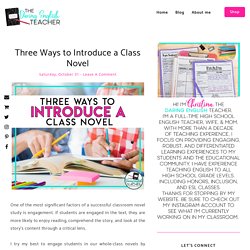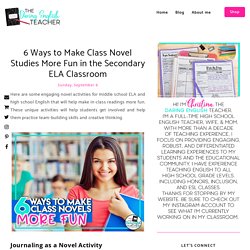

Three Ways to Introduce a Class Novel. One of the most significant factors of a successful classroom novel study is engagement.

If students are engaged in the text, they are more likely to enjoy reading, comprehend the story, and look at the story's content through a critical lens. 6 Ways to Make Class Novel Studies More Fun in the Secondary ELA Classroom. Journaling is an excellent way for students to express what they do or do not understand, which could help them grow as readers.

With journaling, students would need to talk about each chapter and answer questions such as: What do you know so far? What do you like/ not like about this chapter? Think of it like this! A student chooses to read Lord of the Flies, and they record each chapter in their journal and answer the questions. After students finish reading, you could advise them to reflect on their answers and write if anything has changed. For example, say a student did not understand the bullying of Piggy.
Choosing a Class Novel: 8 Questions to Consider. Looking to refresh your curriculum?

Title I money burning a hole in your pocket? Think you might die if you have to read Across Five Aprils one more time? Maybe it’s time to choose a new class novel. Asking all 30 kids to read the same book is a big ask, however. How do you go about choosing a class novel that is worth the time and effort? Du Texte à l'Histoire - Cheminements de l'œuvre vers son contexte. Constat de départ.

Serge Boimare : Apprendre à penser avec Hermès. Publié le 8 septembre 2017.

Quick talk about texts – James Durran. Short-burst pair or group talk activities which can be woven into reading lessons In other posts, I’ve suggested that the most effective whole-class reading sessions allow for seamless weaving together of whole-class discussion, individual thinking time and pair or small group talk. below are some examples of typical, short pair or group talk activities (30 seconds to a couple of minutes) which can be woven into reading lessons so that pupils are required to retrieve and to rehearse knowledge, to develop and refine understandings, and to practise the articulation of these things, as well as develop their independence and their personal and social confidence as readers.

Of course, any of these may well be preceded by silent thinking time, so that individuals are primed for talk. And they are all likely themselves to precede class discussion, in which the teacher will use follow-up questioning and explanation to move pupils’ understanding forward. Discuss. Pauline Lourdel : Pédagogie différenciée de la littérature. 5 Reasons to Have a Classroom Library. While the vast majority of schools have school libraries, classroom libraries play an essential role.

There are many ways to build up your classroom library including shopping at garage sales, library sales, and second-hand stores. Additionally, you can also score some free books by asking friends to donate to your classroom. If you are looking for ways to build your library, you can read my post here. Also, I recently wrote a post about how I organize my library. Here are five reasons to have a classroom library in your classroom. How to Write a Novel Using The Three-Act Structure. The three-act structure is perhaps the most common technique in the English-speaking world for plotting stories — widely used by screenwriters and novelists.

It digs deep into the popular notion that a story must have a beginning, middle, and end, and goes even further, defining specific plot events that must take place at each stage. In this post, we dissect the three acts and each of their plot points — using three-act structure examples from popular culture to illustrate each point. Let’s begin! In three, two, one... Les valeurs de l’enseignement des lettres. 20 Ways To Make Sure a Reader's Workshop Succeeds. A workshop is a physical location where a craftsperson makes something.

A reader is a person who reads. So what’s a reader’s workshop? It’s a place where a reader makes meaning from the words on a page. It sounds easy enough, but it takes knowledge, planning, and consistency to make it work. Here are 20 teachers and readers who are making meaning through their reading each and every day. Why Teachers Should Give Themselves Reading Homework. When was the last time you curled up with a book, and not the latest professional development tome or fifth grade novel that you’re about to teach?

Chances are, not likely. Only 36% of adults read for fun every day (though an additional 23 percent read for pleasure a few times a week). By now it’s old news that reading is good for you: As little as six minutes of reading reduced stress by two-thirds, according to a University of Sussex study,Reading fiction increases empathyReading increases the connectivity in the brain, giving your cerebral cortex a work-out (ABC News). So reading is good for us and we don’t read enough. 15 Literary Analysis Questions to Ask Your Students. When teaching fiction in the middle school ELA or high school English classroom, whether it be a short story or a novel, it is so important to focus on more than just comprehension. While it is important to ask students about what they read, we must also ask them to analyze what they read. When I first teach literature to my students, I use direct instruction strategies. I provide my students with literary analysis terms and examples.
Then we begin short stories and excerpts together. Usually, we will analyze a couple of short stories together as a class before moving onto more substantial pieces, like novels. Eveline Charmeux : Lire, c'est comprendre. "Il existe une relative indépendance entre ce qu'on voit écrit et ce qu'on entend à l'oral. Il serait pour le moins imprudent de faire croire aux enfants que les lettres auraient un son associé à chacune d'elle". Si vous cherchez un spécialiste qui réfute la méthode syllabique : inutile d'aller plus loin. Eveline Charmeux, agrégée de grammaire classique et ancienne professeure en IUFM, ne craint pas la polémique. Son dernier ouvrage, "Lire, c'est comprendre" (éditions universitaires européennes), prend à rebrousse poil la plupart des principes admis actuellement pour l'apprentissage de la lecture.
L'ouvrage présente une démarche (attention ! Dans votre ouvrage vous proposez "d'apprendre intelligemment la lecture". Cela veut dire en faisant appel à l'intelligence des enfants et en la développant. Pourtant le déchiffrage est indispensable à la compréhension ? Dès l'instant où on analyse ce qu'est lire on voit que le déchiffrage n'en fait pas partie. ANAGRAPH - Jérôme Riou. A Classroom Library: If You Build It, They Will Read by Jim Bailey. I had just finished sharing the latest research about classroom libraries with my teachers at a staff meeting. The research didn’t surprise anyone. Using A Jigsaw Activity To Help Every Student Engage With Literature. All-School Read: Building Community & Promoting Understanding.
Four Teaching Moves That Promote A Growth Mindset In All Readers. Teaching Your Students to Read Like Pros. Editor’s note: This piece by Kelly B. Cartwright is adapted from Executive Skills and Reading Comprehension: A Guide for Educators, now available from Guilford Press. Over the last few decades, the use of comprehension strategies to help students read has become increasingly popular. Unlike traditional reading skills that support word reading, such as phonemic awareness and vocabulary, comprehension strategies help students become active, self-regulated thinkers about the meanings of texts that they are reading. Skilled readers regularly employ various cognitive strategies to understand what they’re reading, and teaching this set of strategies results in significant improvements in comprehension for struggling students (Brown et al., 1996; Brown, 2008; Duffy et al., 1988; Pressley et al., 1989). 1. 2. 3. 4. 5. 6. 7.
Bringing These Processes Together in Your Classroom. Five Clever Ideas to Spark Independent Reading by Kids. Giving Students a Little Taste of a Book. I learned about the book tasting—an opportunity for students to try out a variety of books—from an instructional coach at my school, who modeled it for the teachers, enabling us to learn firsthand what this activity can do. To start, I gather titles in a variety of genres from the school library, classroom library, and literacy library—it’s best to have a few copies of each book. I set up my tasting by putting my students in seven groups of four, with four titles in a different genre for each group.
One group is generally realistic fiction, one literary nonfiction, one fantasy, and so forth. How to Help Students Develop a Love of Reading. The Benefits of Reading for Pleasure. Why don’t students read? Most teachers have the goal of promoting students’ lifelong love of reading. But why? Pourquoi les enfants n'aiment pas lire. 5 Ways to Help Struggling Readers With the Whole Student in Mind.
It’s easy to fall into the trap of only focusing on a student’s reading struggles, but we cannot leave the rest of the student behind. When we fail to engage other aspects of the whole child, we also fail to help them connect learning experiences. This increases the likelihood that they will question the value of school, tune out, or worse, feel like they’ve failed and give up. Croisement de la lecture littéraire et de la réflexion philosophique : un nouvel horizon pour l'enseignement du français en collège.
Azelina Lebouteiller, enseignante de lettres modernes en collège. Why Every Kid Should Have Their Own Library Card. September is National Library Card Sign-up Month. If you live in a community with a public library, embrace it! Celebrate the gateway you have been offered into the magical world of free books. Not everyone has that good fortune. Death to Fake Reading: Encouraging Engagement in an Era of Avoidance – Conference on English Leadership (CEL) Note: This post has been cross-blogged on the author’s blog www.failsafely.com. All English teachers are familiar with that gnawing feeling: the paranoid scan of an essay, the neurotic parsing of a student’s response, the subsequent guilt for even daring the thought…this is good, you reflect, perhaps too good.
Generating Effective Questions. Teachers ask an average of 400 questions a day, or 70,000 a year, according to The Guardian. Children Learn Best From Storybooks When Characters Are Realistic. Une fillette de 11 ans se bat pour faire connaître les livres mettant en scène des héroïnes noires. Elle entend ainsi permettre aux petites filles noires de s'identifier à des héroïnes de roman, quand la majorité des livres pour la jeunesse mettent en scène des garçons blancs .
A 11 ans, l'Américaine Marley Dias, ne ressemble ni à Martine, ni au Petit Nicolas. Elle ne fait pas non plus partie du Club des cinq, ni des Six compagnons. Pourtant, elle en connaît un rayon en littérature jeunesse. Cette fillette d'origine jamaïcaine, qui vit dans le New Jersey, sur la côte Est des Etats-Unis, a lancé un club de lecture dont l'ambition est de mettre en avant les aventures de filles noires.
What Works For Getting Kids to Enjoy Reading? #cyberpd 2017: Dynamic Teaching For Deeper Reading #1. Motivating Students to Read. La littérature Jeunesse. Literacy Tips for Parents: What One Teacher Wishes We All Knew. LA DIDACTIQUE DE LA LECTURE ET DE LA LITTÉRATURE À L’AUBE DU XXIe SIÈCLE. Should Students Read Graphic Novels in the Classroom? Yes! Chut : silence on lit. Pour Margaret Atwood, les hommes ont besoin d'un manuel de drague. Concevoir une séquence de lecture "raisonnable" en collège. Conseils aux professeurs stagiaires.